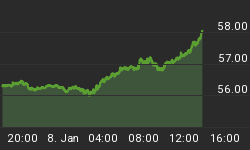Exports unexpectedly declined a sizable 2.1 percent in February. Imports fell 1.3 percent. As a result, the trade deficit widened to -45.7 billion.
Last month, the trade deficit initially came in at -43.4 billion, but revisions increased the reported deficit to -44.7 billion.
Across the board, numbers are much weaker than expected. This is the fourth straight month of falling exports.
Economists missed this report by a mile. The Econoday Consensus estimate was a trade deficit of -43.9 billion.
Highlights
January was a weak month for cross-border trade with exports down a steep 2.1 percent and imports down 1.3 percent, making for a wider-than-expected trade imbalance of $45.7 billion. Exports of capital goods were especially weak as were imports of capital goods, both pointing to weakness in global business investment. Exports of industrial supplies were also down as were exports of consumer goods and also food products. Imports of industrial supplies were also down as were imports of consumer goods. Imports of autos, however, continue to rise to underscore the ongoing strength in vehicle sales.
The goods gap widened to $63.7 billion from $62.6 billion and when excluding petroleum where the gap narrowed, the goods gap widened to $57.8 billion from $55.5 billion. The nation continues to run a strong surplus on services, at $18.0 billion for a small gain in the month.
The gap with China widened in the month to $28.9 billion for a $1 billion increase while the gap with Europe narrowed sharply, to $8.8 billion from $13.7 billion. The gap with Japan narrowed to $4.9 billion from $6.6 billion while the gap with Canada widened to $2.4 billion from $2.2 billion.
Today's report will lower early estimates for first-quarter GDP and no less importantly is the latest indication that global traffic is stalling, which is not a plus for global policy efforts to raise inflation.
Recent History
The nation's trade deficit is expected to widen slightly to $43.9 billion in January vs December's $43.0 billion. Weak global demand has been hurting exports while imports, in a sign of domestic weakness and despite strength in the dollar, have been flat. Last week's advanced data on January showed a narrowing in the goods deficit, down 1.2 percent to $62.2.
Exports Hit Five-and-a-Half Year Low
Reuters has additional details in its report U.S. Trade Deficit Widens as Exports Hit Five-and-a-Half-Year Low.
- In January, exports of goods fell 3.3 percent to $116.9 billion, the lowest level since November 2010.
- Overall exports of goods and services dropped 2.1 percent to their lowest level since June 2011.
- Food exports were the weakest since September 2010.
- Industrial supplies and materials exports fell to their lowest level since March 2010.
- Petroleum exports touched their lowest level since September 2010.
- Exports of non-petroleum products were the weakest since February 2011. Exports to the United States' main trading partners fell broadly in January.
- Imports of goods fell 1.6 percent to $180.6 billion, the lowest level since February 2011. Import growth is being constrained by ongoing efforts by businesses to reduce a stockpile of unsold merchandise.
- Automobile imports were the highest on record.
Rapidly Cooling Global Activity
US exports shrinking is consistent with a rapidly cooling global economy. Here are some additional links on the slowing global economy.
- Global Services Activity at 40-Month Low
- Eurozone Deflationary Pressures Intensify; France PMI Back in Contraction
- Malaise Spreads to Services: US Services PMI Contracts for First Time Since October 2013
Those who think the US will decouple from the global economy are mistaken.
















